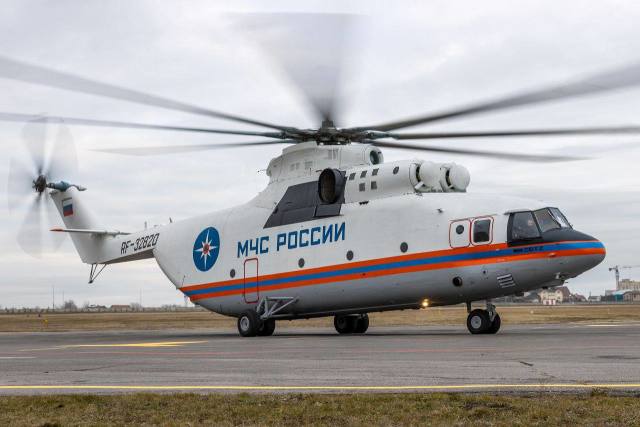The Russian Helicopters Holding Company of Rostec State Corporation has handed over to the Ministry of Emergency Situations of the Russian Federation the first upgraded Mi-26T2 heavy helicopter with new avionics (avionics) and a "glass cabin". Modern equipment and new electronics have reduced the number of crew and made it possible to fly at any time of the day. The Mi-26T2 heavy class helicopter is an upgraded version of the Mi-26T.
Thanks to modern avionics, the crew of the updated machine has been reduced from five to three people. The latest avionics installed on the aircraft significantly expands operational capabilities, reduces the load on the crew and allows you to fly at any time of the day.
"This is the first helicopter from the Mi-26 line to be delivered to the Russian Ministry of Emergency Situations in such a configuration. Now there are six such large helicopters in the department's fleet. It will be deployed in the Southern Aviation Rescue Center and ensure the security of the Southern and Central Federal Districts. But if necessary, it can be transferred to any region outside these districts. We will attract an aircraft both for the transfer of airmobile groups, evacuation of victims, and for extinguishing wildfires," said the head of the Russian Emergencies Ministry, Alexander Kurenkov.
The avionics includes a modern flight and navigation system, an inertial navigation system, and a GLONASS navigation system. Avionics with a digital autopilot can not only guide the Mi-26T2 along the route, but also provide its automated approach with hovering at a given altitude.
"Mi-26 series helicopters can perform a very wide range of tasks, which makes them, without exaggeration, irreplaceable. In one flight, the car is able to evacuate up to 82 people from the disaster site, and in the sanitary version – to transport up to 60 victims and three accompanying medical workers. Mi-26 helicopters are regularly used to extinguish fires. In addition, the heavy rotorcraft allows you to transport 20 tons of cargo of any configuration," said Vladimir Artyakov, First Deputy General Director of Rostec State Corporation.
The "glass cabin" – a system for displaying the main indicators of devices on electronic displays - also increases the convenience of piloting. The helicopter is also equipped with an early warning system about the proximity of the earth. At the same time, almost all systems are duplicated to ensure a higher level of security.
"The Mi-26 is a unique helicopter, there are no analogues in the world in terms of size and payload. Modernization has made it possible to increase the efficiency of the record-breaking helicopter – a modern flight and navigation complex provides the ability to fly both day and night, in difficult weather conditions. This is especially true when conducting rescue operations in the most remote corners of Russia, including in the Arctic and the Far North. The number of crew members has been reduced on the updated machine, which reduces operating costs," said Vladislav Saveliev, Deputy General Director of the Russian Helicopters Holding.
The maximum take-off weight of the Mi-26T2 helicopter is 56 tons with a cargo weight of 20 tons. The Mi-26T2 can climb to an altitude of up to 4,600 meters, the cruising speed of the helicopter is 255 km/ h (maximum – 295 km/h). The range is 800 kilometers with a normal load (1905 kilometers is the distillation range).
The agreement on the supply of the Mi-26T2 heavy helicopter for the Russian Emergencies Ministry was signed during the Army 2020 International Military-Technical Forum.

